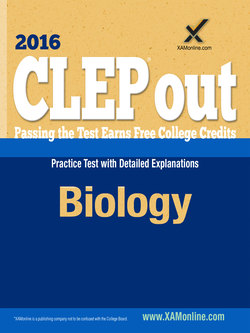Читать книгу CLEP Biology - Sharon A Wynne - Страница 3
BIOLOGY
ОглавлениеDescription of the Examination
The Biology examination covers material that is usually taught in a one-year college general biology course. The subject matter tested covers the broad field of the biological sciences, organized into three major areas: molecular and cellular biology, organismal biology, and population biology.
The examination gives approximately equal weight to these three areas. The examination contains approximately 115 questions to be answered in 90 minutes. Some of these are pretest questions that will not be scored. Any time candidates spend on tutorials and providing personal information is in addition to the actual testing time.
Knowledge and Skills Required
Questions on the Biology examination require candidates to demonstrate one or more of the following abilities.
Knowledge of facts, principles, and processes of biology
Understanding the means by which information is collected, how it is interpreted, how one hypothesizes from available information, how one draws conclusions and makes further predictions
Understanding that science is a human endeavor with social consequences
The subject matter of the Biology examination is drawn from the following topics. The percentages next to the main topics indicate the approximate percentage of exam questions on that topic.
33%Molecular and Cellular Biology
Chemical composition of organisms
Simple chemical reactions and bonds
Properties of water
Chemical structure of carbohydrates, lipids, proteins, nucleic acids
Origin of life
Cells
Structure and function of cell organelles
Properties of cell membranes
Comparison of prokaryotic and eukaryotic cells
Enzymes
Enzyme-substrate complex
Roles of coenzymes
Inorganic cofactors
Inhibition and regulation
Energy transformations
Glycolysis, respiration, anaerobic pathways
Photosynthesis
Cell division
Structure of chromosomes
Mitosis, meiosis, and cytokinesis in plants and animals
Chemical nature of the gene
Watson-Crick model of nucleic acids
DNA replication
Mutations
Control of protein synthesis: transcription, translation, posttranscriptional processing
Structural and regulatory genes
Transformation
Viruses
34%Organismal Biology
Structure and function in plants with emphasis on angiosperms
Root, stem, leaf, flower, seed, fruit
Water and mineral absorption and transport
Food translocation and storage
Plant reproduction and development
Alternation of generations in ferns, conifers, and flowering plants
Gamete formation and fertilization
Growth and development: hormonal control
Tropisms and photoperiodicity
Structure and function in animals with emphasis on vertebrates
Major systems (e.g., digestive, gas exchange, skeletal, nervous, circulatory, excretory, immune)
Homeostatic mechanisms
Hormonal control in homeostasis and reproduction
Animal reproduction and development
Gamete formation, fertilization
Cleavage, gastrulation, germ layer formation, differentiation of organ systems
Experimental analysis of vertebrate development
Extraembryonic membranes of vertebrates
Formation and function of the mammalian placenta
Blood circulation in the human embryo
Principles of heredity
Mendelian inheritance (dominance, segregation, independent assortment)
Chromosomal basis of inheritance
Linkage, including sex-linked
Polygenic inheritance (height, skin color)
33%Population Biology
Principles of ecology
Energy flow and productivity in ecosystems
Biogeochemical cycles
Population growth and regulation (natality, mortality, competition, migration, density, r- and K-selection)
Community structure, growth, regulation (major biomes and succession)
Habitat (biotic and abiotic factors)
Concept of niche
Island biogeography
Evolutionary ecology (life history strategies, altruism, kin selection)
Principles of evolution
History of evolutionary concepts
Concepts of natural selection (differential reproduction, mutation, Hardy-Weinberg equilibrium, speciation, punctuated equilibrium)
Adaptive radiation
Major features of plant and animal evolution
Concepts of homology and analogy
Convergence, extinction, balanced polymorphism, genetic drift
Classification of living organisms
Evolutionary history of humans
Principles of behavior
Stereotyped, learned social behavior
Societies (insects, birds, primates)
Social biology
Human population growth (age composition, birth and fertility rates, theory of demographic transition)
Human intervention in the natural world (management of resources, environmental pollution)
Biomedical progress (control of human reproduction, genetic engineering)
